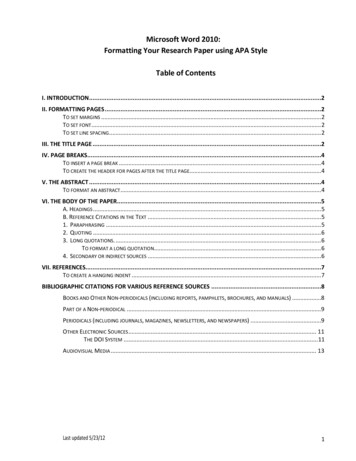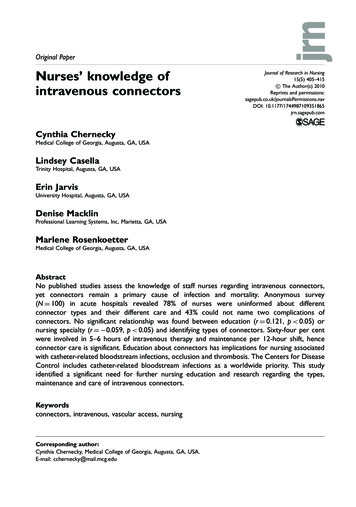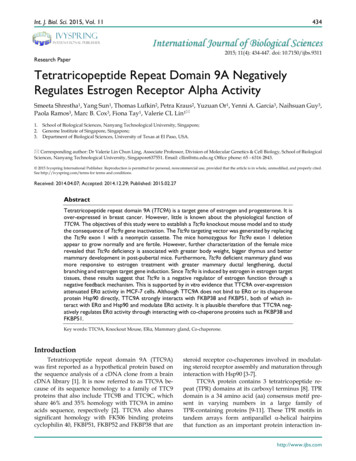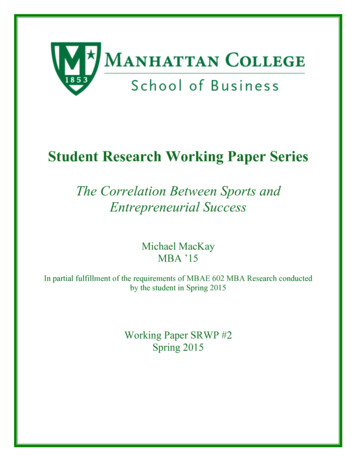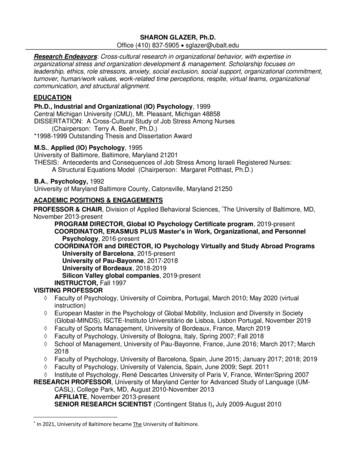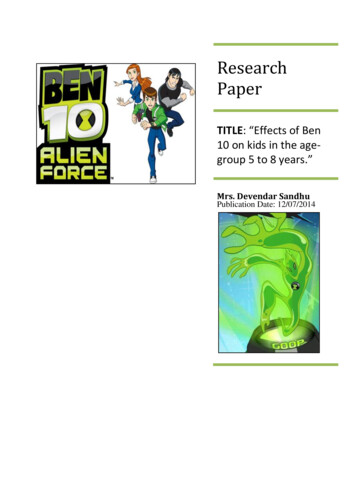
Transcription
ResearchPaperTITLE: “Effects of Ben10 on kids in the agegroup 5 to 8 years.”Mrs. Devendar SandhuPublication Date: 12/07/2014
Educational Technology Research PaperAbstract“The problem with our society is that our values aren‟t in the right place. There‟s an awful lot of bleedingand naked bodies on prime-time networks, but not nearly enough cable television on publicprogramming.”― Bauvard, Evergreens Are PrudishTechnology has expanded the availability of information through various routes, such as, television,music, movies, internet and magazines. These routes avail children to endless learning venues about anyissue that might be of interest to them. Television is a common media mode which is available to mostIndian houses. As per the Turnaround Management Association „s TAM Annual Universe Update - 2010,India now has over 134 million households (out of 223 million) with television sets, of which over 103million have access to Cable TV or Satellite TV. Kids are exposed to TV at a very young age and theyview TV actively or passively without any filtrations, one program after the other. Unless parents areempowered with expert information, they are ill-equipped to judge which programs to place off-limits fortheir kids.This retrospective descriptive study explores whether kids and their parents felt the side effects ofviewing Ben 10. The sample population of 30 kids in the age – group 5 to 8 years old and their parentsparticipated in the research. Factors examined in the study were psychological effects, health effects, TVcontents rating views, etc.The Ben 10 Diet Questionnaire was administered to kids and parents (N 30) to explore how much timeand type of media they consumed as they were in their formation years. Data from the survey establishedthat there are psychological and health effects of Ben 10 on their young kids. Results indicated thatparents thought, 12- 15 years is the right age- group for the kids to view Ben 10. They also thought thatTV owes them Proper Consumer Advice related to the programmes they broadcast in form of TV contentratings according to Indian standards.ii
Educational Technology Research PaperTable of Contents Abstract . ii1. INTRODUCTION . 1a. Statement and significance of the Problem . 1b. Statement of Purpose . 4c. Research Questions . 5d. Summary . 52. REVIEW OF LITERATURE . 6a. Theoriesi. Social Learning Theory . 7ii. Cultivation Theory . 10iii. Fluorescent Theory . 11iv. How violence of TV affects your child . 12v. Media Violence . 133. METHODOLOGYa. Design . 14b. Setting . 14c. Population and Sample . 14d. Measures . 14e. Instruments used . 154. RESULT . 16a. Data Obtained from the Questionnairesb. Research Questions- 1c. Research Question- 2d. Research Question- 3e. Additional Findings5.6.7.8.AssumptionsLimitationsAPPENDICE A . 23APPENDICE B . 269. REFERENCES . 2910. TABLES AND GRAPHSa. Table 1: Data obtained from questionnaires of kids and parents . ib. Table 2: Likert items shown in graph . 17c. Table 3: 5 point Likert scale and their ranks . 17iii
Educational Technology Research Paperd. Table 4: Demographics . 17e. Table 5: Comparing answers from respondents . 20f. Graph 1: Psychological Aspects . 18g. Graph 2: Health Aspects . 18h Graph 3: Content Ratings . 18i. Graph 4: Parental Views . 19j. Graph 5: Responses of parents regarding TV content ratings . 21iv
Effects of Ben 10 on kids in the age- group 5 to 8 years1. IntroductionToday, TV viewing takes up a large part of children‟s waking time and they are deeply affected by it.Most kids plug into the world of television long before they enter school. According to the Kaiser FamilyFoundation (KFF):11. Two-thirds of infants and toddlers watch a screen an average of 2 hours a day kids under age 6watch an average of about 2 hours of screen media a day, primarily TV and videos or DVDs.12. Kids and teens 8 to 18 years spend nearly 4 hours a day in front of a TV screen and almost 2additional hours on the computer (outside of schoolwork) and playing video games.13. Kids who view violent acts are more likely to show aggressive behaviour but also fear that theworld is scary and that something bad will happen to them.TV characters often depict risky behaviour such as kicking, hitting, shooting, etc. They do so in order todestroy the bad guy and not try to solve the problems. In next episode another bad guy comes up withproblems. The problem- solving ability of kids is totally crushed, with a lesson for the kids that hitting thebad person is the solution to solve the problem (justifying violence).a. Statement and significance of the problemWe are immensely affected by what we see. And so is it with children. According to the Social LearningTheory (Bandura, Albert. 1971) it is clear that Children observe the people around them behaving in1various ways [ ]. Same is true for TV also. Children learn through imitation of characters on TV as well asmovies. Today, TV is an easy alternative to a full- time nanny in almost every home. Children are mostlyleft unattended while watching TV. Most of the parents even today, still consider all cartoon animationprogrammes appropriate for their kids.With high- level of creativity in the media field, today all animations are not appropriate for all agegroups. Gone are the days, when cartoon and animations were restricted to Mickey Mouse and Supermanonly. Today, on one hand there are Family guy, South Park, etc. as the adult animation, on the other handDragonball Z, Pokemon, etc. are the action adventure animation series. Doraemon, Transformers:[1]McLeod, S. A. (2011). Albert Bandura Social Learning Theory. Retrieved fromhttp://www.simplypsychology.org/bandura.html1
Effects of Ben 10 on kids in the age- group 5 to 8 yearsGeneration 2, etc. are a part of science fiction (sci-fi) animation series. The Simpsons, Courage theCowardly Dog, etc. are the family animation series.There are many more genres in the field of entertainment and just as 35mm motion pictures can begrouped in various genres, animation movies and animated tv- series can also be grouped in similargenres. The commonly overlooked fact is that animation is not a genre but an art form, a medium, atechnique used in the entertainment field especially for kids but not only by kids.A very popular animated television series is Ben 10: Alien Force. It is an American animated televisionseries created by team Man of Action (a group consisting of Duncan Rouleau, Joe Casey, Joe Kelly,and Steven T. Seagle) and produced by Cartoon Network Studios. It is a sequel to Ben 10 [2]. It was a verypopular animated TV series which had forty- six episodes and ran for three years (2008- 2010).In this research paper, Effects of Ben 10: Alien Force (Ben 10: AF) have been studied on kids in the agegroup 5 to 8 years. This series of Ben 10 was very popular and influential. Children (esp. boys) followedit very closely and were highly affected by every episode. It was darker than its predecessor involvingunnecessary aggression, repeated & elongated action scenes andviolence, high degree of consumerism, usage of Americanvocabulary, etc. Shortly after the launch of the series consumermarket was flooded with toys namely Ben 10 Omnitrix, Tiffinboxes, bed sheets, T-shirts, video games, etc.When kids got to touch and feel the Omnitrix (a very powerful,Figure 1: Omnitrix toywatch-like alien device attached to Ben‟s wrist which allows himto transform into various alien creatures) they related to it more closely and followed it more intently.Kids believed more in the TV series and believed that they might be lucky enough to get a real omnitrixsomeday. The T-shirts, masks, bizarre alien forms, etc. goods made them feel more close to their iconBen 10, Gwen, Kevin, etc.Ben 10 animated series extensively uses fluorescent colours in the animations. According to theFluorescent colour theory “Where a clean, bright conventional color is able to reflect a maximum of 90%of a color present in the spectrum; a fluorescent color can reflect as much as 200% to 300%.”[3] There area number of negative health effects that have been linked to working under fluorescent lights that aretheorized to be caused by this body chemistry mechanism such as:[2]“Ben 10: Alien Force”, www.wikipedia.org . Web. Last modified on 27 April 2013http://en.wikipedia.org/wiki/Ben 10: Alien Force[3]The Mechanism of Color. -theory/2
Effects of Ben 10 on kids in the age- group 5 to 8 years Migraines Eye strain Problems sleeping, due to melatonin suppression Anxiety disorder, etc. [4]Excessive use of fluorescent colours with constant flickering of light shown as an effect for bangs,weapons, explosions, etc. series of Ben 10: AF form a deadly combination for the eyes of their viewers.The bright lights make the viewers (kids) strain their eyes, keeping them hyper- alert causing eye- strains,while they are watching the program. As a matter of fact, what we see makes us who we are.[5] So, theparents and the kids should be careful in making their choices for viewing the right contents and more ageappropriate programmes.There should be a precise, age appropriate and detailed Television content rating system in India to helpviewers make right choices for the cartoon programmes for kids i.e. a proper Consumer Advice should beprovided to the viewers of TV programmes. Parents and kids should be made more aware about the TVrating system for cartoons. As opposed to only two ratings on TV namely:- U – Universal and UA –Parental Guidance there should be more child- specific, age- based ratings in India. For example:1. Canada RatingsFigure 2: Canadian TV Ratings: C,C8, G, PG, 14 , and 18 2. Australian Classification Board (ACB) TV ratings. [6]Figure 3: Australian Ratings[4]Adams, Chris. “How Fluorescent Lights Affect You and Your Health”. k R Forehand; Rohit Deshpande JMR, Journal of Marketing Research; Aug 2001; 38, 3; ABI/INFORMGlobal (phrase has been picked-up by them but is used with cartoon program as opposed to advertising as in theoriginal form)[6]Television content rating systems. www.wikipedia.org. Web. Last modified on 10 May 2013http://en.wikipedia.org/wiki/Television content rating systems3
Effects of Ben 10 on kids in the age- group 5 to 8 years3. GreeceWhite rhombus in green background: Suitable for all agesWhite circle in blue background: Suitable for children over 10 years of age; parentalguidance is suggest
In next episode another bad guy comes up with problems. The problem- solving ability of kids is totally crushed, with a lesson for the kids that hitting the bad person is the solution to solve the problem (justifying violence). a. Statement and significance of the problem We are immensely affected by what we see. And so is it with children. According to the Social Learning Theory (Bandura .



